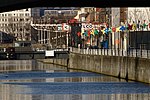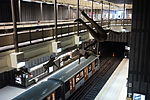Flanders Gate
City of BrusselsFortifications of BrusselsGates in BelgiumUse British English from July 2024

The Flanders Gate (French: Porte de Flandre; Dutch: Vlaamsepoort) was one of the medieval city gates of the second walls of Brussels, Belgium.
Excerpt from the Wikipedia article Flanders Gate (License: CC BY-SA 3.0, Authors, Images).Flanders Gate
Rue Antoine Dansaert - Antoine Dansaertstraat, Brussels Pentagon
Geographical coordinates (GPS) Address Nearby Places Show on map
Geographical coordinates (GPS)
| Latitude | Longitude |
|---|---|
| N 50.853055555556 ° | E 4.3416666666667 ° |
Address
Rue Antoine Dansaert - Antoine Dansaertstraat 202
1000 Brussels, Pentagon
Belgium
Open on Google Maps








